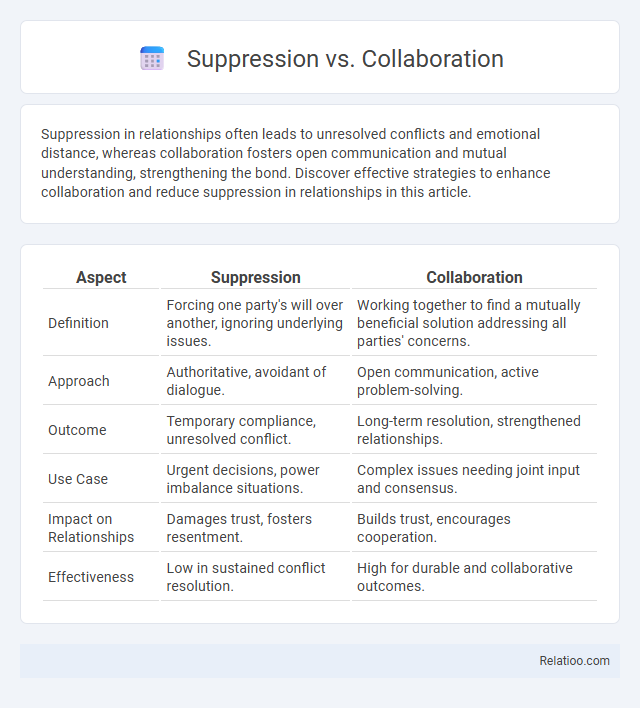Suppression in relationships often leads to unresolved conflicts and emotional distance, whereas collaboration fosters open communication and mutual understanding, strengthening the bond. Discover effective strategies to enhance collaboration and reduce suppression in relationships in this article.
Table of Comparison
| Aspect | Suppression | Collaboration |
|---|---|---|
| Definition | Forcing one party's will over another, ignoring underlying issues. | Working together to find a mutually beneficial solution addressing all parties' concerns. |
| Approach | Authoritative, avoidant of dialogue. | Open communication, active problem-solving. |
| Outcome | Temporary compliance, unresolved conflict. | Long-term resolution, strengthened relationships. |
| Use Case | Urgent decisions, power imbalance situations. | Complex issues needing joint input and consensus. |
| Impact on Relationships | Damages trust, fosters resentment. | Builds trust, encourages cooperation. |
| Effectiveness | Low in sustained conflict resolution. | High for durable and collaborative outcomes. |
Understanding Suppression and Collaboration
Understanding suppression involves recognizing it as a defense mechanism where unwanted thoughts or feelings are consciously pushed out of awareness to avoid distress. Collaboration, in contrast, emphasizes working together harmoniously to achieve common goals, enhancing communication and productivity. Your ability to differentiate these concepts helps improve emotional regulation and teamwork skills in personal and professional settings.
Key Differences Between Suppression and Collaboration
Suppression involves forcibly controlling or limiting actions, often through authority or power, whereas collaboration emphasizes joint effort and mutual contribution to achieve common goals. Your decision between suppression and collaboration impacts team dynamics, productivity, and overall outcomes significantly. Understanding these key differences helps in choosing the most effective approach for managing conflicts or driving projects forward.
Psychological Impact of Suppression
Suppression involves consciously attempting to avoid or inhibit unwanted thoughts and emotions, which often leads to increased psychological distress, anxiety, and decreased emotional well-being over time. Collaboration, in contrast, fosters emotional acceptance and regulation by encouraging open communication and cooperative problem-solving, resulting in improved mental health and resilience. Persistent suppression can exacerbate stress responses and impair cognitive functions, highlighting the importance of adaptive emotional strategies for psychological balance.
The Benefits of Collaborative Environments
Collaborative environments foster innovation and productivity by enabling diverse perspectives to merge, resulting in more comprehensive solutions than suppression or competition alone. You benefit from enhanced communication and trust-building, which streamline problem-solving and decision-making processes. Teams in collaborative settings experience increased motivation and engagement, driving sustained success and adaptation in dynamic workplaces.
Why Suppression Occurs in Teams
Suppression in teams occurs primarily due to power imbalances, fear of conflict, or a lack of psychological safety, causing members to withhold ideas and avoid open communication. When team members feel their input may lead to negative consequences or rejection, suppression becomes a defense mechanism that stifles creativity and problem-solving. Understanding these underlying causes helps leaders foster an environment that prioritizes collaboration and active participation.
Barriers to Effective Collaboration
Barriers to effective collaboration often include poor communication, lack of trust, and unclear roles, which hinder team synergy and productivity. Suppression tactics, such as ignoring dissent or withholding information, exacerbate these challenges by fostering resentment and disengagement among team members. Your team can overcome these obstacles by promoting open dialogue, defining responsibilities clearly, and encouraging mutual respect to enhance collaborative outcomes.
Strategies to Move from Suppression to Collaboration
Shifting from suppression to collaboration requires implementing open communication channels and fostering trust among team members to encourage active participation and idea sharing. You can promote a collaborative culture by setting clear goals, empowering employees with decision-making authority, and recognizing their contributions to enhance motivation and engagement. Integrating collaborative tools and training programs further supports this transition by equipping teams with the skills and resources necessary to work together effectively.
Real-World Examples: Suppression vs Collaboration
Suppression involves controlling or limiting actions, as seen in governmental censorship of media to prevent dissent, while collaboration emphasizes working together, exemplified by international teams uniting to develop COVID-19 vaccines rapidly. In law enforcement, suppression tactics like curfews aim to reduce crime rates quickly, whereas collaboration between police and community organizations fosters long-term trust and public safety improvements. The success of collaborative approaches in environmental conservation projects, such as cross-border wildlife protection programs, contrasts sharply with suppression methods that may provoke resistance and undermine goals.
Building a Collaborative Organizational Culture
Building a collaborative organizational culture requires understanding the differences between suppression, collaboration, and competition, with collaboration fostering open communication and shared goals. Your team thrives when suppression of ideas is replaced by active participation and mutual support, enhancing innovation and trust. Emphasizing collaboration strengthens relationships and drives collective success more effectively than competitive or suppressive dynamics.
Long-term Outcomes of Suppression vs Collaboration
Long-term outcomes of suppression often include increased stress, unresolved conflicts, and damaged relationships due to unmet emotional needs. Collaboration fosters durable solutions by promoting open communication, mutual understanding, and joint problem-solving, leading to stronger trust and improved teamwork. Your choice to engage collaboratively can significantly enhance emotional well-being and relationship resilience over time.

Infographic: Suppression vs Collaboration
 relatioo.com
relatioo.com